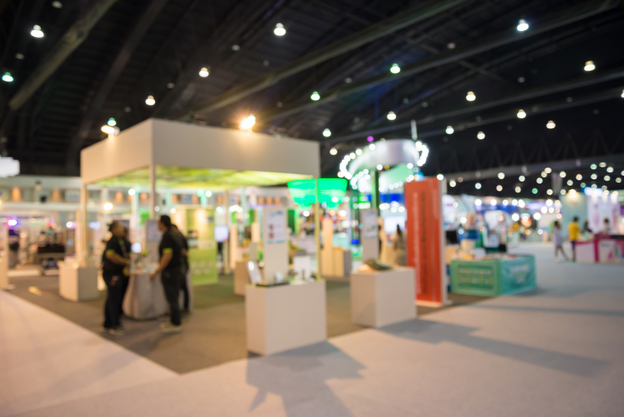In the world of business, trade shows are:
- A unique platform for networking.
- Showcasing your brand.
- Building lasting relationships with potential clients and customers.
They provide an invaluable opportunity to put your business front and center in the eyes of your target audience. As such, your booth—your brand’s home away from home during the event—plays a crucial role in your trade show’s success.
However, creating a booth that stands out in a sea of exhibitors is formidable. This comprehensive guide aims to navigate you through this journey, from understanding the importance of a well-designed booth to measuring your success post-show. With thoughtful strategies, creative design, and careful planning, your trade show booth can be your most potent tool in leaving a lasting impression. Let’s embark on this journey to turn your booth into a success story.
Jump Links
- Introduction to Trade Show Booth Success
- Importance of a Well-Designed Booth
- Understanding Trade Show Attendee Expectations
- Strategizing Your Trade Show Booth Design
- Critical Elements for Crafting the Perfect Trade Show Booth
- Staffing Your Trade Show Booth
- Managing Your Trade Show Budget
- Ensuring Your Booth Stands Out
- Measuring Trade Show Success
- Conclusion: Turning Your Booth into a Success Story
- FAQs
Introduction to Trade Show Booth Success
Trade shows present an unparalleled opportunity for businesses to showcase their products or services, build brand awareness, and cultivate meaningful relationships with potential clients and industry influencers. The epicenter of these engagements is the trade show booth. This article will delve into crafting the perfect trade show booth, helping you transform your next exhibition into a resounding success story.
Importance of a Well-Designed Booth
In the bustling trade show environment, your booth is a powerful visual statement of your brand. The design, therefore, plays a pivotal role in making the first impression. A well-designed booth can turn heads, attract foot traffic, and create memorable interactions. It goes beyond mere aesthetics; it is about incorporating elements that engage attendees and resonate with your brand’s values and mission.
Consider your booth as a physical embodiment of your brand personality. It should speak volumes about who you are, what you offer, and why your offerings matter in the market. Creating this instant, visible connection between your booth and brand identity is a stepping-stone to meaningful customer engagement.
Understanding Trade Show Attendee Expectations
Trade show attendees arrive with a set of expectations. They anticipate discovering new trends, products, or services, learning from industry leaders, and networking with peers. Attendees seek value, education, and entertainment. Understanding and catering to these expectations is critical to a successful booth design.
Think of your booth as a dynamic platform to engage with your audience. It should offer interactive experiences that educate and entertain. The booth design should facilitate conversations, allowing your staff to converse with attendees, understand their needs, and effectively showcase your products or services. Remember, your goal isn’t just to draw attendees to your booth but to leave them with a lasting impression long after the event.
Strategizing Your Trade Show Booth Design
Your booth design should always be considered. It requires careful planning, strategy, and creativity. Understanding your objectives, knowing your audience, and reflecting your brand authentically are fundamental to your plan.
Determining Your Show Objectives
Defining your objectives provides direction for your trade show participation. It clarifies what you hope to achieve, whether it’s launching a new product, increasing brand awareness, gathering leads, or establishing industry connections.
Your objectives should be Specific, Measurable, Achievable, Relevant, and Time-bound (SMART). Once you establish these, use them as the foundation for your booth design. For example, if your objective is to launch a new product, your booth should prominently feature the product, providing attendees with interactive experiences and demonstrations.
Profiling Your Audience
Understanding your target audience is crucial to creating a booth that resonates with them. Consider their preferences, needs, and interests. Identify the problems they face, and highlight how your offerings provide solutions.
Remember that each trade show will attract a unique blend of attendees. Therefore, your booth should be flexible to adapt to different audience profiles and industry events.
Reflecting Your Brand
Your booth should be a three-dimensional representation of your brand. Every element, from colors and graphics to promotional materials and giveaways, should harmonize with your brand identity. This helps create a cohesive, immersive experience for the attendees, enhancing brand recall.
Maintain consistency in your brand messaging across all touchpoints. This includes pre-event promotions, on-site booth design, and post-event follow-up. Such character strengthens your brand image and increases the likelihood of creating meaningful and lasting relationships with attendees.
Critical Elements for Crafting the Perfect Trade Show Booth
Creating an effective booth involves more than just setting up a space with your company logo. It requires carefully selecting and orchestrating various elements to engage attendees and make your brand unforgettable.
High-Impact Visuals
Visual appeal is vital in attracting attention on a crowded trade show floor. Therefore, your booth must-have elements that create visual impact and spark interest among attendees.
Design Psychology
Understanding and implementing design psychology can significantly enhance your booth’s appeal. Humans are wired to respond to specific visual cues; knowing how to incorporate these can make your booth more attractive. For instance, combining curved lines and shapes can elicit warmth and comfort. Using symmetry can convey a sense of balance and professionalism. These subtle design elements can influence attendees’ perceptions of your brand.
Effective Use of Color and Lighting
Colors can evoke emotions and shape perceptions. Select a color palette that aligns with your brand identity and elicits desired emotions. For example, red signifies excitement and urgency, while blue represents trust and reliability.
Lighting is another crucial aspect. Adequate lighting can highlight your products, illuminate graphics, and create a welcoming ambiance. Use a mix of general, task, and accent lighting to create depth, interest, and focus in your booth.
Message Clarity
In a bustling trade show, attendees are flooded with information. Therefore, your booth’s message must be clear and concise to capture and hold attention effectively.
Displaying Core Competence
Your booth should reflect your core competence or what sets you apart from competitors. Whether it’s a groundbreaking product, exceptional service, or innovative technology, make sure this is communicated and demonstrated in your booth.
Quick Grabs – Catchy Taglines and Slogans
A catchy slogan or tagline captures your attention and encapsulates your brand’s essence. Make it visible, memorable, and aligned with your brand identity and messaging.
Booth Functionality
Aesthetics are essential, but they shouldn’t compromise functionality. Your booth should be designed with attendee traffic flow and engagement in mind.
Traffic Flow and Layout
Create a layout that allows easy movement and access to information or products. An open, inviting space encourages more attendees to enter and interact with your staff. Consider having distinct areas for product display, demonstrations, and one-on-one discussions.
Interactive Displays and Demonstrations
Interactive displays engage attendees, providing them with hands-on experience with your products or services. These could include product demonstrations, touchscreen information kiosks, VR/AR experiences, or games. These interactions help create memorable experiences and can lead to deeper engagement post-show.
Technology Integration
Technology can significantly enhance the attendee experience and engagement at your booth. Consider integrating modern technologies such as touch screens, digital signage, and social media into your booth design.
Touch Screens and Digital Signage
Touch screens can provide interactive product information or can be used for lead generation. Digital signage can dynamically showcase product videos, testimonials, or social media feeds, keeping content fresh and engaging.
Social Media and Mobile-First Strategies
Incorporate social media in your booth activities. Encourage attendees to share their experiences using a custom event hashtag on social media platforms. This increases your brand’s visibility and extends engagement beyond the event.
Staffing Your Trade Show Booth
The right team staffing your booth is essential to convert visitor interest into tangible outcomes. They are your brand’s front-line ambassadors, engaging directly with attendees.
Recruiting and Training Staff
Choose a team that’s knowledgeable, approachable, and enthusiastic about your brand. Training is crucial. Ensure your staff is well-versed with your products or services, key talking points, and the overall show objectives. Role-playing exercises prepare your team for different types of interactions they may encounter.
Dress Code and Professionalism
Your staff should be easily identifiable and reflect your brand’s image. A consistent dress code looks professional and helps attendees identify your team members. Regardless of the dress code, ensure your staff maintains a professional demeanor throughout the event.
Exhibitor and Attendee Engagement Strategies
Equip your team with effective engagement strategies. They should know how to initiate conversations, ask open-ended questions, and actively listen to attendees. Remember, the goal is not just to disseminate information but to build relationships. Encourage your staff to capture leads for post-show follow-up.
Managing Your Trade Show Budget
Trade shows are an investment. Managing your budget can help you achieve your objectives without overspending.
Balancing Quality and Cost
Strive for a balance between creating a high-quality booth and staying within your budget. This involves prioritizing elements that add the most value. High-quality graphics, for example, are more impactful than lavish decorations that do not contribute to your messaging.
Financial Benefits of Rental Equipment
Renting booth elements can be a cost-effective solution, especially for companies that do not participate in trade shows regularly. With Quest Events, you can access various rental solutions, from pipe and drape to decor and furnishings. This saves you the cost of purchasing and maintaining these elements and allows you to customize your booth design for different shows.
Ensuring Your Booth Stands Out
In a sea of booths, standing out is crucial. Unique booth designs and strategies to attract attention from afar can help draw more attendees to your booth.
Creative and Unique Booth Ideas
Don’t shy away from thinking outside the box. Unique booth elements can intrigue attendees and make your booth memorable. This could be anything from a themed booth design that resonates with your brand to interactive games, contests, and live demonstrations or performances.
How to Garner Attention from Distance
Your booth should be noticeable from afar. Use tall banners, large hanging signs, or lighting effects to draw attention. Audio elements like music or announcements can also attract attendees.
Measuring Trade Show Success
Evaluating your performance post-show provides invaluable insights and helps refine your strategies for future shows.
Determining Key Performance Indicators (KPIs)
KPIs are metrics that help you measure the effectiveness of your trade show participation in achieving your objectives. These could range from the number of booth visitors, leads generated, and social media mentions to customer engagements, sales closed, and post-show follow-up outcomes. Establish these KPIs before the show and track them throughout.
Post-Show Evaluation and Follow-Up
After the show:
- Conduct a thorough evaluation.
- Compare your outcomes with your predefined KPIs to gauge your performance.
- Collect feedback from your team about what worked and what didn’t.
This information is invaluable for improving future trade show participation. Don’t let your engagement end with the trade show. Follow-up is crucial. Contact the leads you collected during the show, provide additional information they might find helpful, and keep the conversation going.
Conclusion: Turning Your Booth into a Success Story
Crafting the perfect trade show booth is both a science and an art. It involves strategic planning, understanding your audience, creating visually captivating and functional designs, staffing your booth with the right team, and effectively managing your budget. A well-executed booth can be the show’s star, attracting attendees, generating leads, and creating lasting impressions.
At Quest Events, we are committed to helping you turn your booth into a success story. Our range of rental solutions and expert installation services empower you to create memorable booth experiences that resonate with your brand and audience.
FAQs
What makes a successful trade show booth?
A successful trade show booth effectively draws attendees, engages them with your brand, and leaves a lasting impression. This involves an open, inviting space that reflects your brand, interactive elements that provide value to the attendees, clear and concise messaging, and a well-trained team to engage with the attendees.
What are the key elements when designing a perfect trade show booth?
The key elements include a visually appealing design, clear messaging, a functional layout that facilitates traffic flow, interactive displays and demonstrations, incorporation of modern technology, and a well-trained team. Also, consider your booth’s visibility from afar and incorporate unique elements to make your booth stand out.
What are the benefits of renting equipment for a trade show booth?
Renting equipment can be a cost-effective solution, especially for companies that do not regularly participate in trade shows. It saves the cost of purchasing and maintaining equipment and allows customization of your booth design for different shows.
How do I measure the success of my trade show booth?
Success can be measured using Key Performance Indicators (KPIs) that align with your show objectives. These could include booth visitor count, number of leads generated, social media mentions, and customer engagements. Post-show follow-up outcomes, such as additional leads converted or deals closed, also provide insights into the success of your booth.


